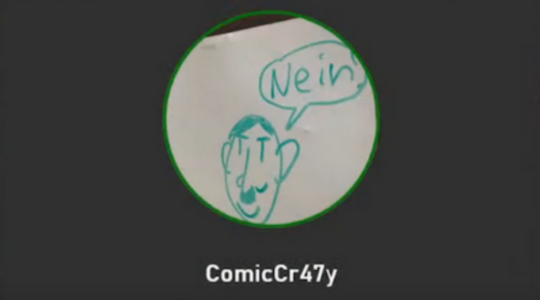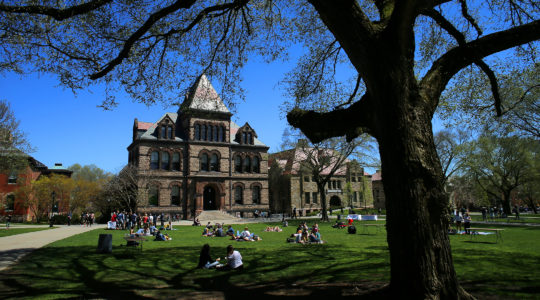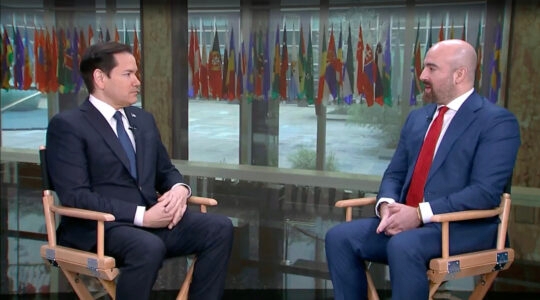
The Bais Menachem yeshiva in Wilkes-Barre, Pa., focuses on wayward Chabad youths. (Uriel Heilman/JTA)
WILKES-BARRE, Pa. (JTA) – The Bais Menachem Youth Development program in this northeastern Pennsylvania city is no typical Chabad yeshiva.
The students wear flip-flops and T-shirts, not the typical black-and-white of Hasidic seminaries. In addition to Jewish law and Bible study, the curriculum includes improv nights, poetry slams and screenings of National Geographic nature shows. The students take taekwondo classes, skiing lessons and canoe trips down the Delaware River. There’s even a house band.
Welcome to the yeshiva for wayward Chabad youths.
“A couple of years ago I was coming out of a very dark time in my life,” said a 17-year-old named Levi who grew up in the Chabad-Lubavitch stronghold of Crown Heights, Brooklyn. “I used to party and smoke marijuana and hang out with very bad people.”
At the yeshiva in Wilkes-Barre, Levi said, he finally found what he needed.
“Instead of just kicking me out for my issues, they looked past them,” he said. “They didn’t look at me as someone who would ruin the school but as someone who needed help. They brought me back to my roots. Other yeshivas treated me like a child, not like an equal. They treated me like a human being.”

Most of the Torah study at the yeshiva in Wilkes-Barre takes place in small groups. (Uriel Heilman/JTA)
In the rule-bound world of haredi Orthodoxy, there’s not much room for boys who don’t conform to the norms of yeshiva life: day-to-night Torah study, adherence to a stringent dress code and strict self-discipline, especially when it comes to foregoing secular pleasures. Those who can’t cope often are rejected and end up leaving the Orthodox fold.
Many years ago, Rabbi Uri Perlman, now 37, was one of those “at-risk” teenagers. But with a little help at a yeshiva in Melbourne, Australia, Perlman managed to turn things around. Today he sports the trademark hat and beard of Chabad Hasidim everywhere.
His experience motivated Perlman to start the Bais Menachem yeshiva in 1999 to give Chabad kids who don’t fit into the typical mold the space to figure out who they are as people and as Jews.
“In the frum community, if you don’t make it in yeshiva, you’re a failure. And when that happens, there’s really no place to turn but down or out,” said Perlman, a native of Wilkes-Barre, where his father is the longtime shaliach, or outreach emissary.
“Nothing is swept under the rug here,” he said. “Our No. 1 goal is they should be happy, healthy people who know who they are. Then work on the Yiddishkeit and on their career.”
RELATED: In fading Pennsylvania city, Jews bet on $11 million hub to save community
The 25 or so boys at this in-residence yeshiva in a dilapidated building adjacent to the leafy campus of Wilkes University have problems ranging from drug and alcohol abuse to pornography addictions. But many are simply kids uninterested in Orthodox Jewish observance or have interests that are frowned upon in the yeshiva world, such as art or popular music.
Bais Menachem has Talmud classes, courses in Jewish philosophy and mandatory prayer services. But the approach is much more laid back, tolerant and individualized than at a typical Chabad yeshiva. If a student doesn’t show up for class, he’s sought out and counseled, not chastised. Those struggling with their faith don’t have to hide it: The teachers are open to discussions about God and doubt. Much of the learning is done one on one or in small groups.

Rabbi Uri Perlman, founder of the Bais Menachem Youth Development program, runs the yeshiva out of a rundown building that used to be a real estate office. (Uriel Heilman/JTA)
“If anyone had doubts about their service to God or maybe feels a little cold toward Judaism, this is a place that can help warm you up,” said Menachem Gudelsky, an 18-year-old from Johannesburg, South Africa. “It’s a place where questions are answered. It’s very tailored to your needs — with a lot of love.”
Gudelsky says the school helped him get through a lot of “humps,” including quitting smoking.
“The goal of the curriculum is for the kids to get an appreciation for Judaism and life,” said Yossi Schulman, a teacher at Bais Menachem. In addition to organizing the curriculum, Schulman helps lead extracurricular vocational training and secures federal E-rate technology funding for the school. Tuition, room and board is about $10,000 per student per year.
In the Chabad world, it’s common for families to ship teenagers to in-residence yeshivas beginning at age 14 or 15. But Bais Menachem is the only Chabad yeshiva in the United States targeting this population and using this kind of approach, according to the school’s administrators and a Chabad spokesman in New York.
Ranging in age from their mid-teens to their early 20s, Chabadniks come to Wilkes-Barre from as far away as England, Australia and South Africa. Some hail from families who are relatively new to the Chabad movement, but many also come from longtime Chabad-Lubavitch families.
Much of the program is non-academic. A smoking-cessation counselor visits from time to time. Students who might benefit from Alcoholics Anonymous meetings are encouraged to attend. On breaks, some of the students smoke on the yeshiva’s front steps or retreat to the adjacent dormitory, where some have decorated their rooms with soccer- and music-related items.
Students are encouraged to volunteer in the community — visiting senior centers, mowing lawns, marching with flags at the Veteran’s Day parade. Because many of the youths are high school dropouts, the yeshiva also offers GED tutoring.
“I never really thought I was going to go back to yeshiva,” said Ari Kasowitz, 21, a native of St. Paul, Minn., who felt he had to hide his secular books and movies when he was enrolled at a standard Chabad yeshiva in Morristown, N.J. “I was done with that. But then a friend invited me here for a Shabbos. I loved it.”
There’s plenty of recreation, from pickup basketball to workouts in the dank basement weight room to skiing and swimming at a local pool. Unusual for an Orthodox yeshiva, the administrators encourage but do not insist on gender-separate swimming.

The basement weight room is one of the features that make Bais Menachem an atypical Chabad yeshiva. (Uriel Heilman/JTA)
“We’re not really enforcing everything that their parents enforce or that we believe in,” Perlman said. “We’re enforcing the fundamentals of Judaism, and we want the rest to be something the students respect and eventually take on. So everybody is asked to put on tefillin, but some kids put it on for just 30 seconds. Nobody gets in trouble for that.”
The average duration of a stay at the yeshiva is two years. Afterward, the students move on to other yeshivas, college or vocational school, or work, according to Perlman. About 25 alumni have gone on to serve in the Israel Defense Forces.
None of the teachers at the yeshiva have any specialized training to deal with at-risk youths, but Perlman says he and the other staffers have learned the skills they need on the job. When needed, the yeshiva brings in psychologists, art therapists and the like.
Eitan Binstok, a 19-year-old from Los Angeles in his third year at the yeshiva, says the school helped him turn his life around.
“There are no facades here,” said Binstok, who is studying the laws of Sabbath for his rabbinical ordination and hopes to begin training soon to be an electrician. “I always thought nobody understands me, that no one has ever been like me before. But coming here you realize there are a lot of people with troubles. And having people you can turn to allows you to grow. The people here actually care.”
While the yeshiva initially encountered much skepticism in Chabad circles, Perlman says the results have changed that.
“A lot of our boys have turned their lives around,” he said. “We’re not trying to create rabbis or shluchim or anything in particular. We’re trying to give the people who come here whatever they need for who they want to be, but without any of the good Jewish things left behind.”
JTA has documented Jewish history in real-time for over a century. Keep our journalism strong by joining us in supporting independent, award-winning reporting.





